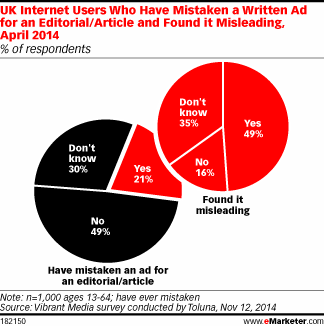Authorities Issue Native Transparency Guidelines
by on 9th Feb 2015 in News


The Internet Advertising Bureau (IAB) has issued guidelines on how to label native ads to UK businesses, along with the backing of fellow trade bodies, such as the Association of Online Publishers (AOP) and ISBA (the self-appointed 'voice of British advertisers'), as spending on such ad formats closes in on £500m a year.
The guidelines instruct advertisers and publishers to clearly demarcate between native advertising and editorial content using visual clues, and that such ad formats must be labelled using wording that demonstrates a commercial arrangement is in place (e.g. ‘paid promotion’ or ‘brought to you by’).
The bodies have taken the move to bring native ad practice in line with the Advertising Standards Authority's (ASA) CAP Code, which governs UK advertisers on issues such as misleading advertising, and were also accompanied by a study on consumers' attitudes to such ad formats.
The guidelines were based on a study specifically commissioned by the IAB to understand consumer attitudes towards consumer research, finding that people decided to engage with native content based on how relevant it is to them, and whether they’ll derive ‘value’ from it; plus, how people's trust in a brand or publisher can diminish if the origin of the content is unclear.
The guidelines are set to be followed up with another set of directives from the trade bodies in the second quarter of this year.
Alex Stepney, IAB, public policy manager, said: “Paid-for advertising units which are deliberately designed to replicate the look and feel of the editorial content that they appear against needs to be obvious to consumers. The guidelines help companies involved in developing and publishing such native ad formats to provide the necessary levels of transparency to consumers and uphold the integrity of online advertising.”
Ian Twinn, ISBA director of public affairs, added: “Advertisers welcome this timely and clear guidance on native advertising. ISBA has worked closely with the IAB to produce the guidelines, a further example of advertising self-regulation that delivers consumer transparency around advertiser funding of digital media.”
The guidelines have been issued after it was revealed that native advertising is growing in popularity among both advertisers and publishers, according to separate studies by the respective bodies.
The IAB's most recent digital spend study revealed that native and content advertising spend – including paid for sponsorships, advertisement features and in-feed distribution – hit £216m in the first half of 2014, accounting for 21% of all display ad spend.
Meanwhile, the AOP's latest Trends & Consensus report identified native advertising as one of the top priorities among publishers eager to improve their bottom lines, with 62% of its members identifying it as a priority when it comes to new business opportunities.
Tim Cain, AOP, managing director, said: "The clear delivery of native advertising is the key to positive consumer interest in both the advertiser and the publisher. The guidelines are an important step in driving that clarity."
To demonstrate the scale of the problem a recent survey from Vibrant Media and Toluna noted how one-in-five UK internet users had mistaken native ad formats for actual editorial coverage, with a further 30% expressing confusion when it comes to distinguishing between the two types of content (see charts below). 
Rebecca Muir, ExchangeWire, head of research and analysis, notes that while there is a great opportunity posed by native, poorly executed formats can be a "true disaster" for the industry as a whole, as misleading, irrelevant, and poorly targeted, instances can compromise the integrity of all involved.
She adds: "Native is a fantastic opportunity for advertisers and publishers because it allows advertisers to present more information to consumers, which in turn gives consumers more information to use to make a decision as to whether they want to click and publishers can blend advertising into their property much better without compromising the UI or relegating ad inventory to the bottom of the page."
AdvertiserDigital MarketingDisplayEMEANativeRegulation








Follow ExchangeWire